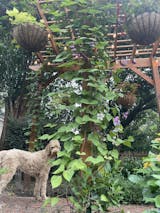
Purple Moon Hyacinth Bean (Pole)
$7.80
100%
Non-GMO
Free
Shipping
Service
Guaranteed
Also Known As: Hyacinth Bean, Pole Beans, Lablab Beans, Papaya Bean, jahe, Njahi, Bonavist Pea, Dolichos Bean, Seim or Sem Bean, Egyptian Kidney Bean, Indian Bean, Bai Bian Dou, Bataw, Australian Pea.
| Plant Name: | Hyacinth, Purple Moon (Pole) |
| Latin Name: | Lablab purpureus |
| Days to Germinate: | 6-10 |
| Days to Harvest: | 60-120 |
| Plant Height: | 6 - 10 Feet |
| Spread: | 3 - 4 Feet |
| Growth Habit: | Vining |
| USDA Zones: | 2-11, Perennial 10-12 |
| Lifespan: | Annual |
| Brand: | TomorrowSeeds |
| Sunlight: | Full Sun, Partial Shade |
| Pollination: | Heirloom, Open-Pollinated |
| GMO: | No |
| Fungicide-Treated Seeds*: | No |
| Seeds Packed For**: | 2025 |
**Seeds are freshly packed for the growing season of the year listed. Seeds are still viable beyond pack date. Store in a cool and dry location such as the refrigerator or basement to best preserve germination rates.
Planting Instructions:
Soil Preparation:
Choose an area with heavy, well-draining soil that receives at least 6 hours of sunlight each day. Remove weeds, large rocks, and litter from the planting area. Leave small weeds and dead grass, they will enrich the soil when turned under. Spade or till the soil 8-12 inches deep. Loosening the soil will help the plant establish strong roots.
Plants grow best in soil with lots of organic matter. You may optionally add fertilizer or organic material such as compost, leaves, or rotted hay to mix into the soil at this point. For small gardens, scatter 2-3 tablespoons of a low-nitrogen fertilizer evenly and work into the top 2-3 inches of soil for each hill or 2 foot by 2 foot planting area. For larger gardens, scatter 2-3 pounds of a low-nitrogen fertilizer for each 100 square feet of planting area. Work fertilizer or organic material into the soil and leave the surface smooth.
Form rows of soil beds 4-6 inches high and at least 3 feet apart. This formation of ridges will help with drainage.
Planting:
Hyacinth bean germination may benefit from soaking the seeds in water for 4 hours prior to planting. Hyacinth Beans grow best in temperatures between 65F-85F. Direct-sowing is recommended. Plant Hyacinth beans in the spring after all danger of frost has passed and the soil temperature reaches at least 60F. For fall crops, direct sow seeds outdoors 8-10 weeks before the first frost. Plant pole beans in hills about 3 feet apart in the row, placing a 6-8-foot stake in the center of each hill. Plant 3-4 seeds around the stake about 1 inch deep in the soil. If choosing to thin to the strongest plants, plant 4-5 seeds around stakes, determine the strongest and healthiest plants, then remove all other plants, narrowing to 3-4 plants per stake. Cover seeds thinly with soil and water after planting.| Planting Depth: | 1 inch |
| Within-Row Spacing: | 3 feet |
| Between-Row Spacing: | 3-4 feet |
Care During the Season:
Watering: Hyacinth beans are drought-tolerant once established. Water to a depth of 6-8 inches once a week. Water especially during flowering and pod formation. Sandy soils may need to be watered more often than heavy clay soils. Mulching around plants can help retain moisture.
Weeding: Keeping plants weed-free improves production. If plowing or hoeing, do not dig deeper than 1 inch to prevent from cutting the feeder roots.
Fertilizing: Fertilizer is usually not required for hyacinth beans unless planting in very sandy soils. Optionally apply additional low-nitrogen fertilizer at the flowering stage, following fertilizer instructions. Water plants after fertilizing.
Insecticides: Insecticides may be used to protect plants. Bt-based insecticides and sulfur are organic options that can be used for prevention. Sulfur also has fungicidal properties and helps in controlling many diseases. Before using a pesticide, read the label and follow cautions, warnings and directions.
Diseases: If spots or mold appear, treat plants with an approved fungicide. Neem oil, sulfur, and other fungicides may be used. When using fungicides always follow label directions.
Harvesting:
Hyacinth beans can be harvested for edible pods or for dry beans, about 65 to 90 days after planting. To harvest Hyacinth beans for edible pods, pick young immature pods when they are young, tender, and about 2 to 3 inches long, before the seeds inside become too large and tough. Note that hyacinth beans must be cooked thoroughly to remove natural toxins. For fodder, hyacinth bean is usually harvested at flowering or in the early green fruit stage. If harvesting for dry beans or seeds, allow the pods to mature fully on the plant until they are dry, brown, and brittle. Once mature, pick the pods and shell the beans for storage or planting. To harvest, use clean scissors or pruning shears to snip the pods from the vine to avoid damaging the plant. Regular harvesting of young pods encourages the plant to produce more. Hyacinth beans should be harvested before the first frost.















